#finite element method
Explore tagged Tumblr posts
Text
TEFUGEN: Redefining Engineering Excellence through Finite Element Analysis
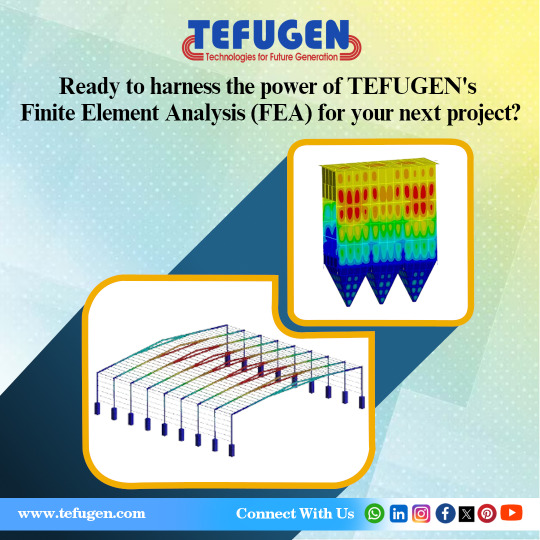
WHY USE FEA IN YOUR ENGINEERING PROJECTS?
At the forefront of engineering excellence, TEFUGEN offers exceptional Finite Element Analysis (FEA) services in India. Utilizing FEA yields unparalleled benefits, offering profound insights into your project's performance prior to physical model construction. It aids in pinpointing stress points, identifying potential weaknesses, and assessing material durability under diverse conditions, effectively mitigating the risk of failure and associated costs. With its ability to conduct precise simulations, FEA empowers informed decision-making in design modifications, guaranteeing optimal performance and safety.
Structural Integrity Assessment:
In engineering, FEA, an indispensable method, meticulously assesses structural integrity by simulating material responses to diverse conditions. This predictive analysis is pivotal for guaranteeing the safety and reliability of designs. TEFUGEN, as a FEA consulting service in India, provides expert assistance, enabling engineers to identify potential weaknesses and optimize for durability.
Thermal stress analysis:
FEA analysis services play a key role in assessing heat distribution within structures or components. Engineers leverage this analysis to model and analyze thermal behavior meticulously. By doing so, they optimize designs for efficient heat dissipation or retention, ensuring the performance and reliability of the system. This detailed analysis enables engineers to make informed decisions regarding material selection, insulation, or heat management strategies, ultimately enhancing overall system efficiency and longevity.
Mechanical Component Design:
FE Analysis plays a crucial role in optimizing mechanical component design by accurately predicting stress, strain, and deformation. This ensures components can effectively withstand operational loads while minimizing material usage, thereby enhancing efficiency and cost-effectiveness.
Fatigue Analysis:
Engineers use FEA for fatigue analysis, predicting the lifespan of components subjected to cyclic loading. This is crucial in industries like aerospace and automotive, where understanding material fatigue is paramount.
Fluid Structure Interaction:
Fluid Structure Interaction (FSI) is a crucial aspect of FE Analysis, examining the dynamic interaction between fluids and structures. By simulating how fluids affect nearby structures and vice versa, FSI enables engineers to optimize designs for enhanced performance and durability across various industries.
Modal analysis Modal analysis using FEA techniques enables the simulation of eigenfrequencies and eigenmodes, revealing the vibrational characteristics of a structure. Meanwhile, harmonic analysis facilitates the emulation of peak responses to specific loads, offering insights into system behavior. These analyses are indispensable tools for understanding structural dynamics and optimizing performance.
Motion study Unlocking insights into structural behavior through Finite Element Analysis (FEA) motion studies. Discover the intricate dynamics of systems, optimize designs, and ensure structural resilience with FEA motion analysis.
#Finite Element Analysis Consulting Services in India#FEA Analysis Services#FEA Consulting Engineers#FEA Consultants in Trichy#FEA#Finite Element Method#Structural Analysis#Stress Analysis#Static Analysis#Dynamic Analysis#Thermal Analysis#Fluid Flow Analysis#Vibration Analysis#Fatigue Analysis#Buckling Analysis#Modal Analysis#Meshing#Boundary Conditions#Material Properties#Convergence#Post-processing#Optimisation#Mesh Generation#Simulation Software
0 notes
Text
Little P.Eng. Engineering For CIPP Liner Design As Per ASTM F1216 Using Finite Element Method
In the realm of civil engineering, the rehabilitation of pipelines is a critical task that ensures the longevity and safety of underground infrastructure. One of the most innovative and efficient methods for pipeline rehabilitation is Cured-in-Place Pipe (CIPP) lining. This technique not only offers a less intrusive alternative to traditional pipeline repair but also significantly reduces the environmental impact and cost associated with excavation. Little P.Eng. Engineering, a pioneering firm in the engineering consultancy landscape, has taken strides in optimizing CIPP liner design to comply with ASTM F1216 standards through the application of the Finite Element Method (FEM).
Understanding ASTM F1216 and its Significance
ASTM F1216 is a standard that outlines the procedures for rehabilitating existing pipelines using the CIPP method. This standard is critical as it provides guidelines for the design, installation, and testing of CIPP liners, ensuring that rehabilitated pipelines meet specific safety and performance criteria. Compliance with ASTM F1216 is essential for any project involving CIPP lining, as it not only guarantees the structural integrity of the rehabilitated pipeline but also its longevity.
Little P.Eng. Engineering's Approach to CIPP Liner Design
Little P.Eng. Engineering has embraced the challenges of CIPP liner design by leveraging the Finite Element Method (FEM), a sophisticated computational technique that simulates how materials behave under various conditions. FEM allows engineers to model the complex interactions between the CIPP liner and the host pipe, taking into account factors such as material properties, external loads, and environmental conditions. By using FEM, Little P.Eng. Engineering can predict the performance of CIPP liners with high accuracy, ensuring that designs are not only compliant with ASTM F1216 but also optimized for durability and efficiency.
The Role of Finite Element Method in Ensuring Compliance and Optimization
The Finite Element Method plays a pivotal role in Little P.Eng. Engineering's design process by providing a detailed analysis of stress distribution, deformation, and potential failure points within the CIPP liner. This detailed analysis is crucial for two main reasons:
Compliance with ASTM F1216: FEM analysis helps ensure that the designed CIPP liner can withstand the intended service life under varying conditions, as stipulated by ASTM F1216. This includes assessing the liner's ability to handle internal pressures, ground movement, and other environmental factors without compromising its structural integrity.
Optimization of Design: Beyond compliance, FEM enables Little P.Eng. Engineering to optimize the thickness, material composition, and installation parameters of CIPP liners. This optimization not only reduces material costs but also minimizes the risk of over-engineering, ensuring that resources are used efficiently without sacrificing performance.
Case Studies and Success Stories

Conclusion
The innovative approach of Little P.Eng. Engineering to CIPP liner design, grounded in the rigorous application of the Finite Element Method and adherence to ASTM F1216 standards, represents a significant advancement in pipeline rehabilitation technology. This method not only ensures the structural integrity and longevity of CIPP liners but also exemplifies how engineering innovation can lead to more sustainable and cost-effective infrastructure solutions. As the demand for efficient and environmentally friendly rehabilitation methods grows, the work of Little P.Eng. Engineering in this field is set to become increasingly important, paving the way for future advancements in civil engineering practices.
Read More:
Innovating Pipeline Rehabilitation: Pipe CIPP Lining Engineering Design Services as per ASTM F1216
Pipeline Rehabilitation Engineering Design Services as per ASTM F1216 Using CIPP and PVC
Little P.Eng. Engineering For CIPP Liner Design As Per ASTM F1216 Using Finite Element Method
Revolutionizing Pipe Rehabilitation: Little P.Eng. Engineering's Mastery of CIPP Liner Design via Finite Element Method in Accordance with ASTM F1216
Tags:
Little P.Eng. Engineering
ASTM F1216
structural integrity
design optimization
engineering innovation
material properties
Finite Element Method
underground infrastructure
performance prediction
industry guidelines
CIPP liner design
material optimization
infrastructure longevity
safety criteria
environmental impact
maintenance cost reduction
pipeline rehabilitation
simulation techniques
performance criteria
durability assessment
compliance standards
computational modeling
non-invasive repair methods
failure point identification
sustainable solutions
installation parameters
stress distribution analysis
external loads
civil engineering practices
cost reduction
Engineering Services
•
Pipe Rehabilitation
Located in Calgary, Alberta; Vancouver, BC; Toronto, Ontario; Edmonton, Alberta; Houston Texas; Torrance, California; El Segundo, CA; Manhattan Beach, CA; Concord, CA; We offer our engineering consultancy services across Canada and United States. Meena Rezkallah.
#Little P.Eng. Engineering#ASTM F1216#structural integrity#design optimization#engineering innovation#material properties#Finite Element Method#underground infrastructure#performance prediction#industry guidelines#CIPP liner design#material optimization#infrastructure longevity#safety criteria#environmental impact#maintenance cost reduction#pipeline rehabilitation#simulation techniques#performance criteria#durability assessment#compliance standards#computational modeling#non-invasive repair methods#failure point identification#sustainable solutions#installation parameters#stress distribution analysis#external loads#civil engineering practices#cost reduction
0 notes
Text
vaguely having ambitions for something I'd like to do as a career so it doesn't feel like I completely threw away those years I was at uni but also having no idea how to get there ughh
#I think learning c++ might be a good start? at least two of the structural analysis programs I used in uni used it#and also learning more about finite element method#okay so I have some idea of where to start
1 note
·
View note
Note
Are there any differences between vampire in this world from the vampire we usually know?
Well, there are a LOT of variations in the media so I can't say any of my ideas are unique, but there's some things that stand out in my mind:
Vampires are dead. Technically. But they still function like living human beings. They have to eat, sleep, drink, etc. If they don't, they'll lose weight, they'll become fatigued, they'll get dehydrated. The only difference is that at the point where a human would die, the vampire will not, as long as they have fresh blood in their system. They won't be having a fun time, though.
Blood is the battery of a vampire. They have to keep their bodies alive by stealing the lifeforce from others, since after their death they no longer have a lifeforce of their own. It takes daily blood to stay in good health.
Lifeforce is finite, though. That's why you need to keep drinking. If you stop, your body starts to shut down, bit by bit, returning to its natural state: death.
The tagline of this game is "They say every vampire has a choice when it's reborn. You did not." That choice? Whether to embrace death or a second chance at life.
MC isn't given the choice because they're forced to feed, and once a vampire feeds it becomes impossible not to keep feeding unless they're literally caged with no source of blood. The Blood Haze is FAR too strong; no one has been able to fight against it through sheer willpower alone.
On the topic of blood/lifeforce, it's what fuels all the vampire's 'superhuman' abilities. But vampires in this world are definitely not the overpowered types.
Super speed? Nope. They can run VERY fast, but not beyond what their body would be capable of with the adrenaline pumping, like if they were running for their life. The difference is, they have a lot of control over their body functions to the point where they can kickstart the adrenaline to make them run fast on command. The cost is a fraction of their lifeforce.
Super strength is the same. Those tiny women who pick up cars when their kids are trapped underneath? A vampire can use the blood in their system to trigger that level of strength on command (with practice).
Healing is a bit different. Because of the level of control a vampire has over its own body mixed with the supernatural elements, it goes much further than what a regular human is capable of. Vampires don't scar. They can regrow limbs and organs. They don't age. It requires focus to do it fast, and a whole lot of lifeforce. A vampire who regrows their arm or heals a bullet wound will need to drink blood ASAP afterwards!
To kill a vampire, the ultimate goal is to separate it from a source of lifeforce. The best and most efficient way is to use fire to burn it to ashes. Sunlight is a great alternative method for a slow, torturous death!
Another way is to lock it up and let it slowly return to death. (A lot of the 'old school' vampires preferred this method against their enemies, as a kind of dignified and natural end.) Chopping off its head might not work if there's enough lifeforce there to regrow its body, so it's quite an impractical solution. None of the religious stuff works against them, no stakes to the heart, garlic, running water, or silver bullets, etc.
I've been debating writing a hunter's manual as a side project tbh LOL. A fun way to write vampire lore from an in-universe perspective.
29 notes
·
View notes
Text
[I could be wrong. Is it possible the Black Heart will beat again?]

<<This place is a message… and part of a system of messages… pay attention to it!>>


They mistake the vessel for its contents. They confuse the pieces with the whole. They see their imprisonment as empowerment. They are hostages of their flesh, unable to see without vision. Unable to hear without sound. Unable to slake their thirst for fear of drowning. Their ignorance is their saving grace. Yet one among them understands, in their limited fashion. They pour from one vessel to another. A welcome change. A new form. Another method of gifting death. I am made finite. Personal. Bright and delicate to hide my true form. An intimacy. They think me contained, but I am instead diffused, as vapor upon the wind. Once again, I am becoming.
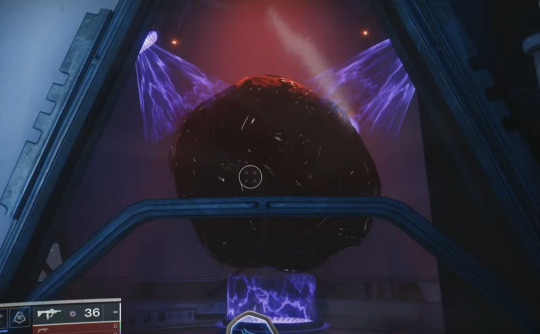
There is a great deal of difference between the source of the power, the power itself, and the hand that shapes it.... do you know where the lines are drawn, Guardian?

<<Sending this message was important to us. We considered ourselves to be a powerful culture.>>
MARA: I touched the mind of that being - that monster - only once.
MARA: I sensed its purpose. Not the purpose itself, but the idea of purpose.
EIDO: The final shape. What it seeks to achieve, with all the tools it has gleaned over the years. This... eternal, perfect thing.
MARA: The language it uses is illuminating. Peak. Pinnacle. Pyramidion.
MARA: The broad base of the pyramid, focusing and sharpening as it builds toward its highest point.
MARA: Self-improvement, or what that being believes to be self-improvement.
[Here, I began to realize something. Excitement rushed through me like lightning.]
EIDO: Dissecting, reassembling. Taking, merging. All those things point towards what the Witness sees as the final shape.
EIDO: It is not simple destruction, the march of entropy. The ruined garden.
EIDO: It seeks... compression. The combination of a chosen past and limitless future into a perfect forever. A state of being that cannot be anything else, because it is everything it could be.
MARA: Taxidermy.
[She had to explain the practice to me. What strange hobbies Golden Age humans had! The metaphor was quite apt.]

EIDO: But it cannot achieve this goal, can it? Not perfectly.
EIDO: What it does instead is mutilation. Its tools leave scars on reality. Great wounds that do not heal. It may preserve some elements, but it always botches the process.
MARA: It cannot accomplish what it envisions—its true ideal of the final shape—without the Traveler's power.
MARA: How it must rankle, to be forced to rely upon the being it loathes.
[She smiled without humor.]
MARA: I hope the Guardian is properly grateful for this gift, Scribe Eido. You have shown them more than an opening move; you have laid bare their opponent's guiding principles.
[I could not help but chirp with pride. I might have felt embarrassed, but Marakel seemed amused…then suddenly serious.]
MARA: Last night, I had a dream.
[I sat up straight.]
MARA: It began in nothing. Neither Light nor Dark; the absence of both. But in that nothing, I began to perceive an impossible something.
MARA: Stone hands clutching at the fabric of the sky. A mountain of screaming bone. A crumbling spire choked by kudzu. A great cancerous growth. Necrotic tendrils digging into flesh, which was earth. Darkness turned gangrenous, strangling the Light.
MARA: But I was not afraid. As I woke, I felt the lingering warmth of a campfire, chasing the chill from my hands.
[She leaned forward. Though I was the one who recorded her words, I believe she was speaking to you.]
MARA: It is not too late.
TRANSCRIPTION ENDS
<<This place is not a place of honor… no highly esteemed deed is commemorated here… nothing valued is here.>>
April is the cruellest month, breeding Lilacs out of the dead land, mixing Memory and desire, stirring Dull roots with spring rain. Winter kept us warm, covering Earth in forgetful snow, feeding A little life with dried tubers. Summer surprised us, coming over the Starnbergersee With a shower of rain; we stopped in the colonnade, And went on in sunlight, into the Hofgarten, And drank coffee, and talked for an hour. Bin gar keine Russin, stamm’ aus Litauen, echt deutsch. And when we were children, staying at the archduke’s, My cousin’s, he took me out on a sled, And I was frightened. He said, Marie, Marie, hold on tight. And down we went. In the mountains, there you feel free. I read, much of the night, and go south in the winter.

What are the roots that clutch, what branches grow Out of this stony rubbish? Son of man, You cannot say, or guess, for you know only A heap of broken images, where the sun beats, And the dead tree gives no shelter, the cricket no relief, And the dry stone no sound of water. Only There is shadow under this red rock, (Come in under the shadow of this red rock), And I will show you something different from either Your shadow at morning striding behind you Or your shadow at evening rising to meet you; I will show you fear in a handful of dust. Frisch weht der Wind Der Heimat zu Mein Irisch Kind, Wo weilest du? ‘You gave me hyacinths first a year ago; ‘They called me the hyacinth girl.’ —Yet when we came back, late, from the Hyacinth garden, Your arms full, and your hair wet, I could not Speak, and my eyes failed, I was neither Living nor dead, and I knew nothing, Looking into the heart of light, the silence. Oed’ und leer das Meer.

Madame Sosostris, famous clairvoyante, Had a bad cold, nevertheless Is known to be the wisest woman in Europe, With a wicked pack of cards. Here, said she, Is your card, the drowned Phoenician Sailor, (Those are pearls that were his eyes. Look!) Here is Belladonna, the Lady of the Rocks, The lady of situations. Here is the man with three staves, and here the Wheel, And here is the one-eyed merchant, and this card, Which is blank, is something he carries on his back, Which I am forbidden to see. I do not find The Hanged Man. Fear death by water. I see crowds of people, walking round in a ring. Thank you. If you see dear Mrs. Equitone, Tell her I bring the horoscope myself: One must be so careful these days.

Unreal City, Under the brown fog of a winter dawn, A crowd flowed over London Bridge, so many, I had not thought death had undone so many. Sighs, short and infrequent, were exhaled, And each man fixed his eyes before his feet. Flowed up the hill and down King William Street, To where Saint Mary Woolnoth kept the hours With a dead sound on the final stroke of nine. There I saw one I knew, and stopped him, crying: 'Stetson! ‘You who were with me in the ships at Mylae! ‘That corpse you planted last year in your garden, ‘Has it begun to sprout? Will it bloom this year? ‘Or has the sudden frost disturbed its bed? ‘Oh keep the Dog far hence, that’s friend to men, ‘Or with his nails he’ll dig it up again! ‘You! hypocrite lecteur!—mon semblable,—mon frère!”
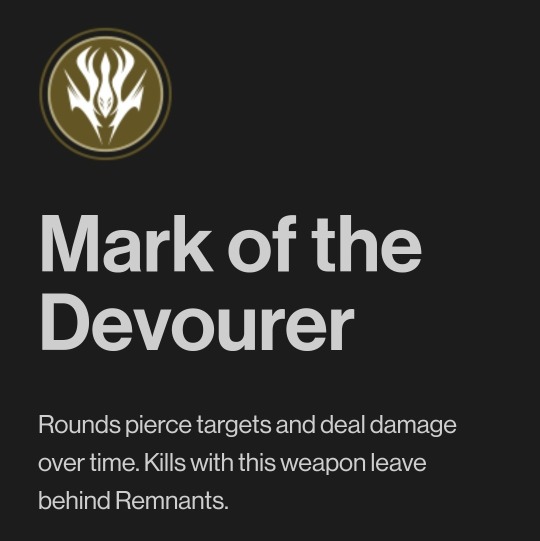
<<What is here was dangerous and repulsive to us. This message is a warning about danger.>>
Oryx went down into his throne world. He went out into the abyss, and with each step he read one of his tablets, so that they became like stones beneath his feet.

He went out and he created an altar and he prepared an unborn ogre. He called on the Deep, saying:
I can see you in the sky. You are the waves, which are battles, and the battles are the waves. Come into this vessel I have prepared for you.
And it arrived, the Deep Itself.
<<The danger is in a particular location… it increases towards a center… the center of danger is here… of a particular size and shape, and below us.>>

ARENA DESIGNATION: Cathedral of Dusk
Dreadnaught, Rings of Saturn
As soon as the first Guardians penetrated the Dreadnaught, Shaxx's Redjacks launched a boarding party to Oryx's fortress. By war’s end, they'd fought all the way to the ship’s “impossible weapon,” the Dark ordnance that obliterated the Awoken fleet.
It was there they found what the Warlocks named the “Cathedral of Dusk.” A Hive burial site for— what? A former master of Oryx? Comrade? Lover? It was vile. And obvious that Oryx never expected the Light to reach so deep inside his throne, to such an intimate space. But he didn’t expect a lot of things — like a Guardian training ground atop the husk of his dead ship.
I dive to understand.
I must be calm. I must record my thoughts. Now I think of the OXA Machine, eternally lost and eternally rebuilt, passed down from civilization to civilization like a ship's black box. I think of the legends of the Hive King Oryx and his quest to pass into the Deep. I took that story as an allegory. I think I was wrong.
<<The danger is still present, in your time, as it was in ours.>>

A dream of a friendly conversation with someone impossible to see, cloaked in shadows. It leaves behind an impossible data fragment to mark its passing.
Here is what a flower knows.
(The fact that a flower may know anything is a conceit that will have to be accepted as metaphor, but to constantly qualify into perfect precision wears thin, does it not? So, here is what a collection of chloroplasts and pigment can know.)
The direction of the sun.
The presence of the rain.
The tangle of the roots.
The distress of another plant.
The hands of the gardener, whether they prune or transplant or crush.
A flower cannot know much else. But the reality of the garden is vast and wild. A flower knows not the fence; a flower knows not the footpath. And yet there is an infinite cosmic garden, which is not any less real simply because the flower cannot possibly comprehend it…
Let us try this again. Stop me if you've heard this one: A gardener and a winnower sit down to play a game outside of time and creation. Yes?
Yes. Then we're agreed. The metaphor stands. Let us iterate.
A gardener and a winnower set out their chairs and play a game of flowers. The flowers know only that they grow or wither, struggle or flourish. Sometimes, they are touched by one hand or the other, and that influence is the closest they will know of the divine.
A flower and a flower spread their leaves to the sun above. (Remember that the sun is also a metaphor: a thing said beautifully, winnowed down to poetry, when the truth is too vast to put in words at all.) They jostle for space, each competing to be the pinnacle of their shape. One flourishes. One withers. Is it the fault of the flower or the fault of its position?
A gardener and a winnower sit down to play a game called Possibility. This is a game about a garden, which is to say that it is also a game about flowers, just as a game about a living being must also be a game about organs and bacteria.
A gardener and a winnower collaborate to create a protein. Whose hand is it in the design, that shortens one life to extend the rest?
It is the winnower that discovers the first knife, but it is not done without the gardener. This, too, is a tradition: a knife does not come to exist without something that must be cut. A woody stem, a colored petal, a vital vessel. The first victims of the blade.
All of these are true.
All of these are false, for metaphor simplifies as the knife does. It pares incalculable concepts into shapes your wrinkly little brains can comprehend. The weight of billions and the simple curve of a planet give you pause, and how then are you to be expected to grasp the forces that created your nth-removed creator?
So the stories woven with utmost delicacy in and around the falsehoods are, after it all, true. There was never any option for the knife to not exist in the garden: it was only ever a matter of time and opportunity.
And as for the shape of the knife itself—
No. That is enough.
I will tell you of gardens.
They are domesticated things, made in a form. As soon as something is called a garden, it is shaped. The plants require the hand of a gardener, for they have become weak and dependent on tender care. They require the hand of a winnower, to cut away the dross, for they are too incapable to do it themselves. In absence of a hand, either the flowers themselves must rise up to wield the knife, or the garden will resolve to meaningless wilderness.
You will say, "But there are plants that can walk! There are seeds that must be scorched by fire to know growth! Existence is more complex than a simple dichotomy between growth and withering, and there is more in heaven and on earth than is dreamt of in this philosophy!"
And I will tell you, clearly:
There can be no gardens without knives.
<<The danger is to the mind, and it can kill.>>

To drink the poison, continue reading.

It tastes of bitter regret and psychosis sweat: a poison to end the thoughts of Human, neohuman, or machine. You see the cosmos before you like a spiderweb of light. Filaments of galactic supercluster shine in the clouds of invisible dark matter, which glue their mass together. Dark energy yawns in the space between all things, ever-growing, ever-spreading.
Chioma Esi, research log: Veil interface, supplemental. They're all dead. Chorus, conductor… everyone. It was too much. Swept their minds away like… like grains of sand on a beach. They're all dead! Maya… Maya called it "valuable data points." Wellsprings and rivers, or… something. What have I done?
<<The form of the danger is an emanation of energy.>>

Life arises. Life spreads, contests itself, and changes. Great things are built and destroyed, but from your vantage point, you see that the victor of each struggle contains—in its negative, in the marks left upon it by the loser and the shapes it assumed to win—the master record of all that it has beaten. Information may not be erased. Whatsoever survives until the end of the cosmos will possess and remember all which came before it.

This is true even of the devouring black hole, which remembers all the secrets it eats. It will only confess these secrets when it evaporates, 10 000 000 000 000 000 000 000 000 000 000 000 000 000 000 000 000 000 000 000 000 000 000 000 000 000 000 000 000 000 000 000 000 000 years from now, long after the last stars have flickered out.

You are a Guardian.

We are all connected. I admit this despite the few people I would rather not share a paracausal connection with. Some people.
…Many people. —Osiris
You must protect life.
We are all pinched silhouettes impaled on the twitchings of infinitely long spiderlegs.
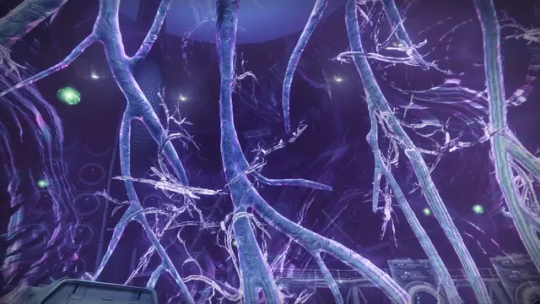
If all life is information, and Guardians strive to preserve life, and information is preserved when it is secret, then you must convert all life into the most secure form of secrets, durable to the end of time.


YOU MUST CAST ALL THE LIFE ||[THIS ONE] YOU [WILL] CHERISH|| INTO A BLACK HOLE


<<The danger is unleashed only if you substantially disturb this place physically. This place is best shunned and left uninhabited.>>
[In the Garden, of the Garden: both descriptions are approximately correct but technically inaccurate, in the same way you can say Schrodinger's cat is at once dead and alive. You and I are both and neither, in and of, extinct and perpetual.
So, there isn't much point in wondering what might have been if we had stayed in our familiar prism-prison or kept tightrope-walking across the quantum wilds. Instead, ask yourself is disincorporated immortality really so bad compared to the others' ends? Would you have preferred an attack by vitreous helicoprion or stumbling over the edge of unreality?
Imagine if we didn't have each other; at least we're not cut off, like the Sol Divisive are from the rest of the Vex. Nor are we beholden to another's purpose. They chose that lonelier path all for a chance to create not simulate, not remake in their image—something truly paracausal. Well, they tried to anyway. Either the blueprint was imperfect or the task impossible or both or neither, but their efforts fell short, so now they're stuck waiting for a resurrection they know will never come.
I could be wrong. Is it possible the Black Heart will beat again?
Of course. The same as everything else, everything that has been and is and will be. And what will become of us then?]
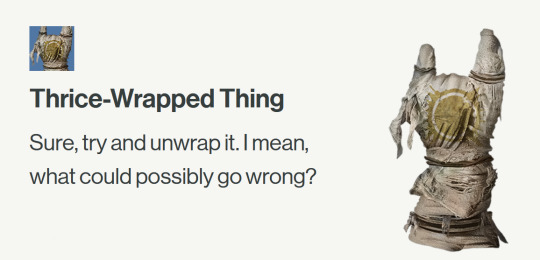
O you wonderful curious things. Do you believe you're the only ones with the power to see what should not be seen? Did you believe you can use such power blithely?
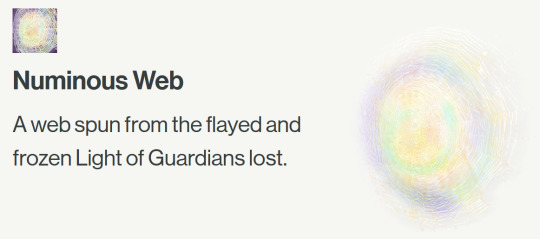
For your trespass, I would ruin your luck, wreak havoc on your drops, poison your engrams, and fill your lines with static. Thus I would curse you and dissipate the bond that ties you to your tasks. How frail you Guardians can be! How many millions have fallen silent, never to return, because the bond did not hold them strongly enough?
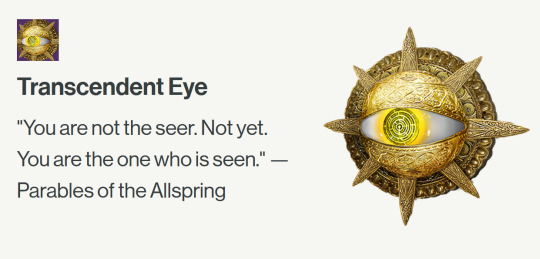
But you have already cursed yourselves. You have walked the Anathematic Arc and glimpsed creation from below. You will never forget the tenuous, provisional framework you found here. You will never forgive the mortality and fallibility that underlies a world you thought was everything.
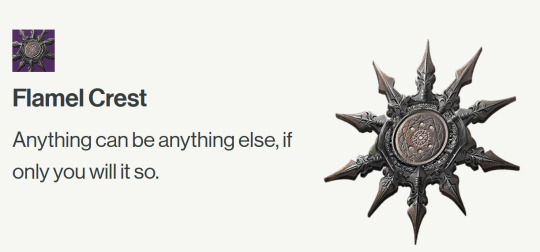
Those who use this power to seek unearned knowledge will see more than they ever desired. There is a price for glimpsing the Cord. You will pay it.
If you ever want to see what's been watching you since the very beginning, just stand on that line, and look...

^
up
youtube
Home by the sea Home by the sea Home by the sea Home by the sea Creeping up the blind side, shinning up the wall Stealing through the dark of night Climbing through a window, stepping to the floor Checking to the left and the right Picking up the pieces, putting them away Something doesn't feel quite right Help me, someone, let me out of here Then out of the dark was suddenly heard Welcome to the home by the sea Comin' out the woodwork through the open door Pushing from above and below Shadows but no substance in the shape of men Round and down and sideways, they go Adrift without direction, eyes that hold despair Then as one they sign and they moan Help us, someone, let us out of here Living here so long undisturbed Dreaming of the time, we were free So many years ago Before the time when we first heard Welcome to the home by the sea Sit down, sit down Sit down, sit down, sit down As we relive our lives in what we tell you Images of sorrow, pictures of delight Things that go to make up a life Endless days of summer, longer nights of gloom Waiting for the morning life Scenes of unimportance, photos in a frame Things that go to make up a life Help us, someone, let us out of here 'Cause living here so long undisturbed Dreaming of the time we were free So many years ago Before the time when we first heard Welcome to the home by the sea Sit down, sit down Sit down, sit down, sit down, sit down As we relive our lives in what we tell you Let us relive our lives in what we tell you Sit down, sit down, sit down 'Cause you won't get away No, with us you will stay For the rest of your days Sit down As we relive our lives in what we tell you Let us relive our lives in what we tell you, oh
One of your philosophers said, "It is not to be thought that the life of darkness is sunk in misery and lost in sorrow. There is no sorrow. For sorrow is a thing that is swallowed up in death, and death and dying are the very life of the darkness." He was a shoemaker. He was right, and it matters more than anything.
#I may have drowned in it this time#trace the vermicular path#truth to power#follow the daito rabbit#destiny 2#destiny the game#destiny#destiny2#d2#destinythegame#d2 lore#destiny lore#the veil#the final shape#lightfall#destiny lightfall#the devourer#Achilles Weaves a Cocoon#savathûn#into the light#destiny 2 the final shape#gaming#long post#long slow whisper
45 notes
·
View notes
Text

The Tree of Life The Alchemy of the Subconscious. Leonora Carrington, 1960
The Tree of Life is a painting of rich symbolism, in which Carrington depicts the Kabbalistic Tree of Life through the use of coloured spheres. The three human figures could be mystics or Jewish rabbis, and some even recognise in these figures the Dance of the Dervishes, which has a profound spiritual and mystical significance.
The composition culminates in a large face of iconographic references taken from Hinduism, Buddhism and even uses elements from the Egyptian world.
A tower of babel of spiritual traditions realised in a stratified composition where different situations occur at the same time and on different levels.

In the mid-sixties, Carrington began exploring Kabbalah lore, a branch of Jewish mysticism that seeks to explain the relationship between the realm of the eternal and unchanging and the finite, ever-changing world. Kabbalistic methods of spiritual realization are, for the most part, the foundation of European alchemy.
43 notes
·
View notes
Note
In other Danganronpa games, in a twisted sort of way, the characters are usually kept in comfort (except for the part where they’re all stuck in a killing game!)
In Tetro however, their care seems to be lacking:
Although the food in the kitchen gets replenished—nothing else is! (Whatever supplies are in the storage room are finite, whatever is in their bedrooms is finite)
There is no concern over the general health/well being of the participants (as opposed to say, in Despair Time for example, Whit mentions people are provided with all their prescriptions and rooms are kept in optimum conditions for comfort for every individual’s preferences)
There is no concern over lack of sleep (in almost every other game, even if they are denied food—they were allowed rest)
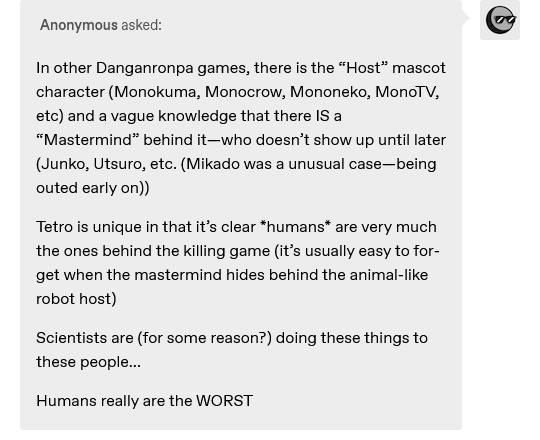
//I have to genuinely disagree with these sentiments on multiple levels:
//First, no misanthropy. We don't do that here.
//Seconds, the scientists in TDP are cruel, don't get me wrong, but let's not act as if any previous masterminds could ever charitably be called "caring." TDP's masterminds are, at best, clinically dismissive of these people and their feelings.
//The masterminds in previous games may have provided everyone with unlimited food and beds and everything, but they also enjoyed tormenting the students at every opportunity. They laugh in peoples' faces, congratulate them on finding the culprit even when they're all in tears, mock them, insult them, and revel in being as cruel as possible.
//And while the motives in TDP have been cruel as well, they're not personal. Other masterminds have been extremely personal and invasive with things like secrets, backstory details, hostages, wishes, dreams, desires, and used them all in the most heartless ways that they could.
//We did get secrets in TDP, but they were shared as a group. In previous games, they were handed out individually to sow chaos.
//Not to mention, as I recall vividly, the masterminds in previous games will absolutely shit over any friendships or relationships, especially ones that get broken up by the killings. That's the element that's really missing from TDP: Mockery.
//So yeah, I disagree that these are our worst masterminds yet. Their methods are cruel, but they lack that personal and petty cruelty that comes with many others.
8 notes
·
View notes
Text
My boss's boss just sent in a group chat of all the section the Wikipedia article of the finite element method for solving differential equations... What does he want
4 notes
·
View notes
Text
Me, haughtily: Sure, my new computer is called a gaming laptop, and has a setting which causes the keyboard to glow with gaudy technicolor backlighting, but you have no idea why I really have it. Do I play video games on it? Do I run long multithreaded monte carlo simulations of the diffusion of fluorescent molecules across cell membranes? Do I use finite element-based methods to simulate the stresses on a heated, rapidly rotating steam turbine with thousands of degrees of freedom?
Arrested Development narrator voice: Mostly, he played video games on it.
4 notes
·
View notes
Text
Revolutionizing Pipe Rehabilitation: Little P.Eng. Engineering's Mastery of CIPP Liner Design via Finite Element Method in Accordance with ASTM F1216
In the realm of civil engineering, the use of trenchless technologies for pipeline rehabilitation has gained significant traction due to their efficiency and minimal disruption to infrastructure. Among these methods, Cured-In-Place Pipe (CIPP) lining stands out as a versatile solution for renovating deteriorating pipelines. Little P.Eng. Engineering has embraced this innovation, revolutionizing pipe rehabilitation through its mastery of CIPP liner design. Leveraging the Finite Element Method (FEM) and adhering to the rigorous standards set forth by ASTM F1216, Little P.Eng. Engineering has propelled CIPP technology to new heights, ensuring optimal performance and longevity of rehabilitated pipelines.
Introduction: Traditional methods of pipeline repair and replacement often involve extensive excavation, leading to disruption of roads, landscapes, and utilities. In contrast, trenchless technologies such as CIPP offer a non-disruptive alternative, where a flexible liner is inserted into the existing pipe and cured in place, effectively creating a new pipe within the old one. Little P.Eng. Engineering has emerged as a pioneer in this field, employing advanced engineering techniques to enhance the efficacy of CIPP liner design.
Finite Element Method in CIPP Design: Central to Little P.Eng. Engineering's approach is the utilization of the Finite Element Method (FEM) in CIPP liner design. FEM allows for the accurate modeling and simulation of structural behavior under various loading conditions, enabling engineers to optimize the design for strength, flexibility, and durability. By simulating the interaction between the liner and the host pipe, potential issues such as wrinkling, ballooning, and stress concentrations can be identified and addressed prior to installation, ensuring a robust rehabilitation solution.
Adherence to ASTM F1216 Standards: In the realm of CIPP technology, adherence to industry standards is paramount to guaranteeing the quality and reliability of rehabilitated pipelines. ASTM F1216 provides comprehensive guidelines for the installation and testing of CIPP liners, covering aspects such as material properties, installation procedures, and quality control measures. Little P.Eng. Engineering's commitment to compliance with ASTM F1216 ensures that its CIPP designs meet the highest standards of performance and safety, instilling confidence in clients and regulatory bodies alike.
Benefits of Little P.Eng. Engineering's Approach: The fusion of FEM-based design and adherence to ASTM F1216 standards endows Little P.Eng. Engineering's CIPP solutions with several key benefits. These include:
Enhanced Structural Integrity: By meticulously analyzing the behavior of CIPP liners under various conditions, potential structural weaknesses are identified and mitigated, resulting in a more durable and long-lasting rehabilitation solution.
Minimized Environmental Impact: The trenchless nature of CIPP technology reduces the need for excavation, minimizing disruption to the surrounding environment and reducing carbon emissions associated with traditional repair methods.
Cost-Effectiveness: Through precise engineering and optimization, Little P.Eng. Engineering's CIPP designs minimize material usage and installation time, translating to cost savings for clients without compromising on quality or performance.
Regulatory Compliance: By strictly adhering to ASTM F1216 standards, Little P.Eng. Engineering ensures that its CIPP solutions meet regulatory requirements, facilitating smooth project approval and implementation.

Conclusion: Little P.Eng. Engineering's mastery of CIPP liner design through the application of Finite Element Method and adherence to ASTM F1216 standards represents a significant advancement in the field of pipeline rehabilitation. By combining innovative engineering techniques with a commitment to quality and compliance, Little P.Eng. Engineering is revolutionizing pipe rehabilitation, offering sustainable, cost-effective, and reliable solutions for the preservation of critical infrastructure.
Read More:
Innovating Pipeline Rehabilitation: Pipe CIPP Lining Engineering Design Services as per ASTM F1216
Pipeline Rehabilitation Engineering Design Services as per ASTM F1216 Using CIPP and PVC
Little P.Eng. Engineering For CIPP Liner Design As Per ASTM F1216 Using Finite Element Method
Revolutionizing Pipe Rehabilitation: Little P.Eng. Engineering's Mastery of CIPP Liner Design via Finite Element Method in Accordance with ASTM F1216
Tags:
Little P.Eng. Engineering
ASTM F1216
Regulatory standards
Finite Element Method
Environmental impact
Cost-effectiveness
Longevity
Material properties
Infrastructure
Structural integrity
Structural analysis
Civil engineering
Infrastructure preservation
Project approval
Sustainable solutions
Non-disruptive
Quality control
Pipeline integrity
Stress simulation
Excavation reduction
Pipe rehabilitation
Compliance assurance
Carbon emissions
CIPP lining
Project implementation
Durability optimization
Pipeline renovation
Performance optimization
Engineering innovation
Trenchless technology
Engineering Services
Pipe Rehabilitation
Located in Calgary, Alberta; Vancouver, BC; Toronto, Ontario; Edmonton, Alberta; Houston Texas; Torrance, California; El Segundo, CA; Manhattan Beach, CA; Concord, CA; We offer our engineering consultancy services across Canada and United States. Meena Rezkallah.
#Little P.Eng. Engineering#ASTM F1216#Regulatory standards#Finite Element Method#Environmental impact#Cost-effectiveness#Longevity#Material properties#Infrastructure#Structural integrity#Structural analysis#Civil engineering#Infrastructure preservation#Project approval#Sustainable solutions#Non-disruptive#Quality control#Pipeline integrity#Stress simulation#Excavation reduction#Pipe rehabilitation#Compliance assurance#Carbon emissions#CIPP lining#Project implementation#Durability optimization#Pipeline renovation#Performance optimization#Engineering innovation#Trenchless technology
1 note
·
View note
Text

Exploring the mechanical and morphological rationality of tree branch structure based on 3D point cloud analysis and the finite element method - Satoru Tsugawa, Kaname Teratsuji, Fumio Okura, Koji Noshita, Masaki Tateno, Jingyao Zhang & Taku Demura
9 notes
·
View notes
Text
The Riemann rearrangement theorem and net convergence
So we all love the Riemann rearrangement theorem, right? Given a conditionally convergent series, like the alternating harmonic series (1 - 1/2 + 1/3 - 1/4 + ...), we can permute its terms in such a way that we can make the resulting series 'sum' to any value we want, or we can have it not converge at all. This violates one of our core intuitions about sums of numbers, namely that it is a commutative operation.
Let's construct a theory of infinite series that corresponds more closely to how addition should behave. First of all, observe that the 'input' of an infinite series (the 'data structure' of the domain) is a sequence of numbers, indexed by the natural numbers. If our summation method is to correspond to finite addition, it should work just as well for infinite multisets of numbers. We then think of a particular sequence of numbers as merely representing the multiset of its terms.
A directed set is a kind of ordered set, traditionally represented by the Greek capital Λ. The ordering ≼ on Λ is required to be a reflexive and transitive relation (a preorder) such that any finite subset Λ' ⊆ Λ has an upper bound. More precisely, we have a rule that associates to the subset Λ' an element i ∈ Λ such that j ≼ i for all j ∈ Λ'. Note that this is equivalent to the statement that Λ is non-empty and every two elements of Λ have a common upper bound. A net in a set X is a function n: Λ -> X for some directed set Λ. A sequence is a special case of a net, where Λ is the natural numbers with their standard ordering.
The properties of directed sets allow us to talk about eventuality. If Φ is some property that elements of X can have, then we say that a net n: Λ -> X is eventually Φ if there is some i ∈ Λ such that for all j ≽ i we have that n(j) satisfies Φ. We also say that n is frequently Φ if for all i ∈ Λ there is some j ≽ i such that n(j) satisfies Φ.
There's a succinct way of thinking about this that uses filters, but you don't need to be familiar with what a filter is to follow. The eventuality filter ℇ(n) of a net n is the set of all subsets S of X such that n is eventually contained in S. We can then say that n is eventually Φ if and only if there is some S ∈ ℇ(n) such that all x ∈ S satisfy Φ, and n is frequently Φ if and only if every S ∈ ℇ(n) contains some x that satisfies Φ. There's a pleasant duality between these conditions.
If the codomain X is a topological space, then we can speak about convergence and limits of nets. For a point x ∈ X we say that a subset N ⊆ X is a neighbourhood of x if there is some open subset U ⊆ X such that x ∈ U ⊆ N. The set 𝒩(x) of all neighbourhoods of x is called the neighbourhood filter of x. Let n: Λ -> X be a net. We say that x is a limit of n if for every neighbourhood N of x we have that n is eventually contained in N. This is succinctly captured by the statement that 𝒩(x) ⊆ ℇ(n). We call the net convergent if it has at least one limit. We say that x is an accumulation point of n if for every neighbourhood N of x we have that n is frequently contained in N. Equivalently, every S ∈ 𝒩(x) and S' ∈ ℇ(n) have non-empty intersection. All limits of a net are accumulation points, and in fact if a net is convergent then its limits are its only accumulation points. It is relatively easy to check that net convergence coincides with sequence convergence if the indexing directed set is the naturals.
As an aside, we cannot technically speak of the limit of a net, as it might not be unique. However, if the topology of your number system is Hausdorff, then limits of nets will be unique (and in fact a topological space is Hausdorff if and only if the limits of all nets are unique). We will assume that our number space is a Hausdorff commutative topological group.
An important thing to note is that the convergence of a net is fully determined by its eventuality filter. This means that if two nets have equal eventuality filters, then they have the same limits and accumulation points. This is one way of formalizing the fact that a sequence converges to a point if and only if every one of its 'tail sequences', where the first however many entries are cut off, converges to that point; a tail sequence has the same eventuality filter.
The set of all finite subsets of the naturals forms a directed set when it is ordered by subset inclusion. The union of two subsets provides a common upper bound. Moreover, if we have a sequence of numbers (xₙ), then to any finite subset S of the naturals we can associate the sum of all xₙ whose indices are elements of S. This is a net, which we denote Σ(xₙ). We define the sum of (xₙ), denoted lim Σ(xₙ), to be the limit of this net, if it exists. Because permutations take finite subsets to finite subsets, the eventuality filter of this net is preserved by permuting the entries of the sequence, so this summation is commutative, and depends only on the multiset of entries of (xₙ). Moreover, it works for any multiset of numbers, it does not need to be countably infinite.
Assume our number system is the field of real numbers with their standard topology. If the series corresponding to the sequence (xₙ) is absolutely convergent, then lim Σ(xₙ) exists and equals the standard limit of the series. Moreover, Σ(xₙ) is convergent if and only if the series of (xₙ) is absolutely convergent.
If all entries of (xₙ) are non-negative, then either Σ(xₙ) is convergent, or it is eventually larger than any finite bound (we could then either say that Σ(xₙ) is divergent, or that it converges to infinity). A similar thing holds if all of the xₙ are non-positive. Now consider an arbitrary sequence of numbers (xₙ). Let (xₙ)⁺ denote its subsequence (or multiset) of positive entries, and let (xₙ)⁻ denote that of the negative entries (we can leave out the entries that are equal to 0, because they do not affect the eventuality filter of Σ(xₙ)). If both Σ(xₙ)⁺ and Σ(xₙ)⁻ are convergent to a finite number, then this is exactly the case that the series is absolutely convergent. If either one is convergent to a finite number, and the other is divergent, then Σ(xₙ) also converges to the same infinity. The interesting things happen when both Σ(xₙ)⁺ and Σ(xₙ)⁻ diverge.
If both Σ(xₙ)⁺ and Σ(xₙ)⁻ diverge, then for any number c we can show that Σ(xₙ) is frequently larger than c and frequently smaller than c. It follows that if Σ(xₙ) has any accumulation points, then this set is an unbounded infinite subset of the real numbers. Consider the series (1 - 1 + 1 - 1 + 1 - 1 + ...), which is sometimes called Grandi's series. The net Σ(xₙ) is frequently equal to any given integer, and all of its entries are integers, so the set of accumulation points is the integers. The alternating harmonic series (the first paragraph of this post seems so long ago) has a more special property, though. Not only can we prove that its sum net Σ(xₙ) is frequently larger and smaller than any given number c, we can also show that it is frequently within any given distance from c. This is because we not only have positive and negative numbers that sum to however much we want, we also have numbers that are arbitrarily small. Because of this, its set of accumulation points is the complete set of all real numbers. And that's the essence of the Riemann rearrangement theorem.
20 notes
·
View notes
Text
Oceans cover most of Earth's surface and support a staggering number of lifeforms, but they're also home to a dilute population of uranium ions. And -- if we can get these particular ions out of the water -- they could be a sustainable fuel source to generate nuclear power. Researchers publishing in ACS Central Science have now developed a material to use with electrochemical extraction that attracts hard-to-get uranium ions from seawater more efficiently than existing methods. Nuclear power reactors release the energy naturally stored inside of an atom and turn it into heat and electricity by literally breaking the atom apart -- a process known as fission. Uranium has become the favored element for this process as all its forms are unstable and radioactive, making it easy to split. Currently, this metal is extracted from rocks, but uranium ore deposits are finite. Yet, the Nuclear Energy Agency estimates that 4.5 billion tons of uranium are floating around in our oceans as dissolved uranyl ions. This reserve is over 1,000 times more than what's on land. Extracting these ions has proven to be challenging, though, as the materials for doing so don't have enough surface area to trap ions effectively. So, Rui Zhao, Guangshan Zhu and colleagues wanted to develop an electrode material with lots of microscopic nooks and crannies that could be used in the electrochemical capture of uranium ions from seawater.
Read more.
15 notes
·
View notes
Text
Tombsona : Lifeform Codex
Multiverse [[fandom]]: The Living Tombstone
Prime [[Canon]] Examples: zero_one, Rust, Armstrong, Tesla, Doc, Geist
Outer dimensional entities transcend time and space and attach themselves to host lifeforms by fate. They are considered rare in and of themselves to every given universe they had first manifested and can span past multiple universes with varying methods of bonding to a host. Some actively profile their hosts while others happen to bond with their hosts in the right set of circumstances. A constant general profile they all share is a skull mask on their faces.
The body of the hosts are infused with mysterious substance called soulite that have a wide range of colors and tones. Some even have been said to master void and infinity but only within certain contexts.
They are not conventionally ‘alive’ and it’s still unclear their actual origins save for legends mentioning a ‘Progenitor’. This has become a double-edged sword because of those who seek their power and/or see tombsonas as an existential threat. Some have gone so far as to create synthetic ones such as Geist in the prime universe. It's unclear if they can find a host or if their existence is finite, at least the hostless ones.
- Full disclosure, there are indeed exceptions to whats layed out in this lifeform codex and it’s also more Fanon/headcanon and is subject to change once more canon information is to come out via TLT’s lore channel (or maybe even here) by Sam Haft himself.
Key
● Common
■ Uncommon
▲ Rare
♦ Ultra Rare
Categories
- Anchored ■
Are anchored to object(s) for unclear reasons. They don't get much in the way of profiling their future host prior to being found.
- Elemental ●
Ones with an elemental affinity to them such as fire, ice, lightning, etc. Their emotional state effects the stability of their elements.
- Ethereal ▲
Those who are more supernaturally inclined. Most in this category tend to be more in the know about their hosts beforehand.
- Polymorphic ●
This type changes the very phycology of their host upon the bonding process being complete.
- Singularity ♦
Tombsonas are usually stronger than regular ones and only a handful of them are in a given universe. They are said to even be considered mere legends even amongst themselves.
Synthetic ▲
Man-made tombsonas usually have a set-in-stone objective programmed into them. Most don’t need a host while a sparse few do depending on their universe’s knowledge on tombsonas in general.
- Hosted ♦
- Non-hosted ●
Color Scheme Variations
- Monochrome ●
- Duo Toned ■
- Tri or Tetra Color ▲
Mask Variations
- Solid ●
- Bright ●
- Dark ■
- Negative Space ▲
- Masquerade ♦
- Mouthed ■
- Duo Toned/Multicolor♦
Mask Attachment Style
- Tied/Straped ●
- Fused ■
- Removable ▲
- Helm ●
Eyehole Variations
- Solid ●
- Asymmetrical ■
- Luminous ●
- Translucent ▲
- Pupiled ■
- Odd Eyed ♦
11 notes
·
View notes
Text
anonymous said : ratio what do you think about a certain gambler & halovian 🎤
⸻ opinions are hardly a standard for judgement , and something veritas typically doesn’t share lightly. but when it comes to maintaining relations , whether business or personal , the scholar is not one to shy away from the honest truth.
❝ a certain gambler , hm ? ❞ plaster conceals facial giveaways , leaving only tonality to convey his thoughts. an element grasped with expertise , providing no emotional cues. ❝ i disagree with plenty of his methods and ideals. he has a tendency to act irrationally and rely on chance without thorough examination which leaves great room for error. however , his supposed lucky streak has kept him afloat until now. but much like all things , they are temporary and finite. ❞ he pauses briefly. allowing his obiter dictum to sink in. ❝ perhaps one day he might err on the side of caution. ❞

now , for the seraphim. a matter he can dish rather impartially , from a bystander viewpoint. ❝ the leader of the oak family is revered for a reason. he has paved the way for the penacony we see now — prosperous , opulent and utopian. few recall the history of the former prison planet before it became the incipient success , and i admit immense admiration for the transformation it has undergone. ❞ though , this is largely retrospection , based on extensive research and conducted observations in his moments upon penacony’s lucrative grounds. ❝ the means behind this radical change is still a mystery , and i suspect the answer lies behind the host. though , it appears this paradise is beginning to crack , and soon we will discover the truth behind the establishment of this phantasmagorical world. ❞
#* ✦ 𝐈𝐈. ❮ asks ❯ ⸻ ❝#* ✦ 𝐈𝐕. ❮ isms ❯ ⸻ ❝#* ✦ 𝐕𝐈. ❮ muses ❯ ⸻ ❝ 「 veritas ratio 」#maybe they should kiss or something idk#i need their dynamics i need the details hoyo
5 notes
·
View notes
Note
Congrats on the trio pacesetter, huge achievement! Watching it made me realize how big the skill disparity is in this game. There’s people that can trio pace or multi toon the overclocked version while I can barely get past normal pace. I’ve seen people multi toon OCLO and CEO and know crazy zap combos which I could never dream of doing. I wonder if everyone can get to that skill level or if it’s just innate talent
thanks! :)
i'd say anything you see other players do in toontown is something anyone can achieve. ofc some people pick up on things faster, it's a matter of doing it enough times or finding a method that "clicks" with you.
i think there does come a certain point within the game where game mechanics become intuitive. for zap combos in particular there are a finite amount of setups people are concerned with which narrows down significantly. coupled with the fact that there are zap charts floating around on the internet, people who are able to call out the correct zap combos to immediately clear a set of 4 are the same as people who are able to do the same with sound combos.
multi'ing bosses are the same way, since they have a finite amount of attacks/mechanics but i'd argue there's still somewhat of a skill check involved bc even if you know those by the back of your hand, there's still an rng element to it on top of a mechanical one since you have to operate more than 1 toon
5 notes
·
View notes